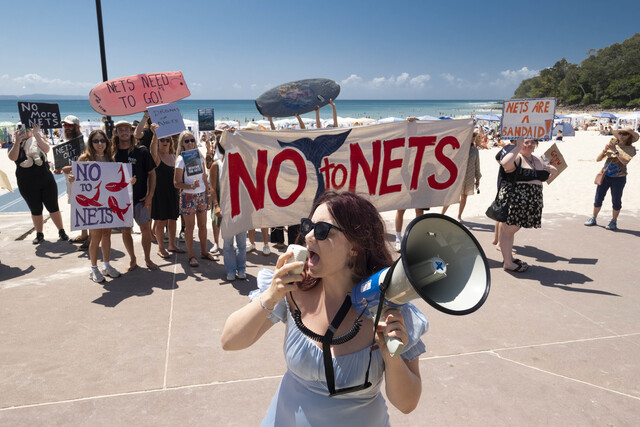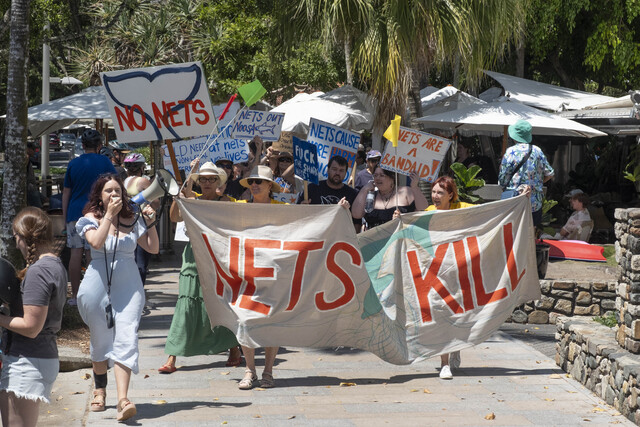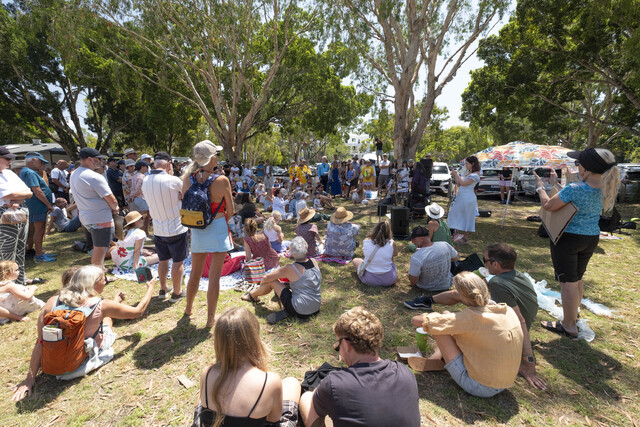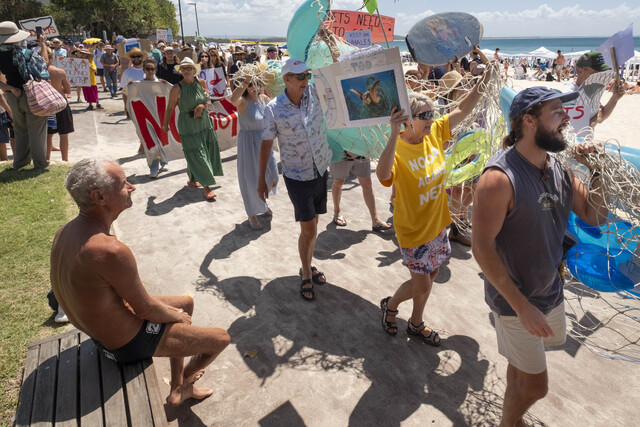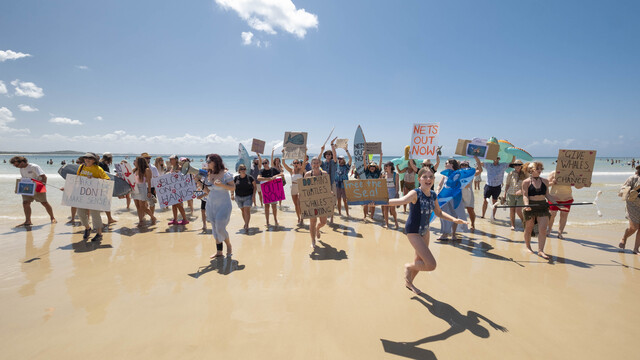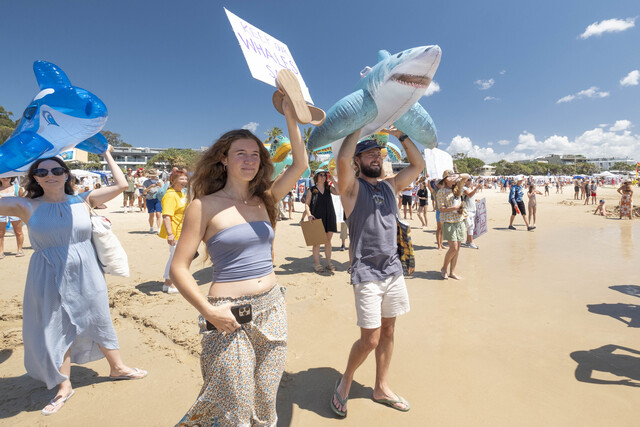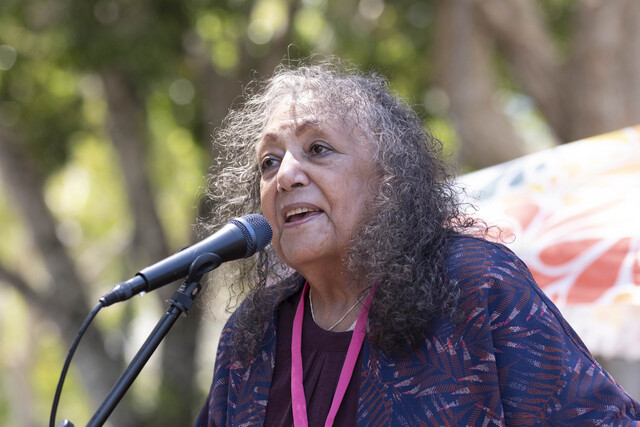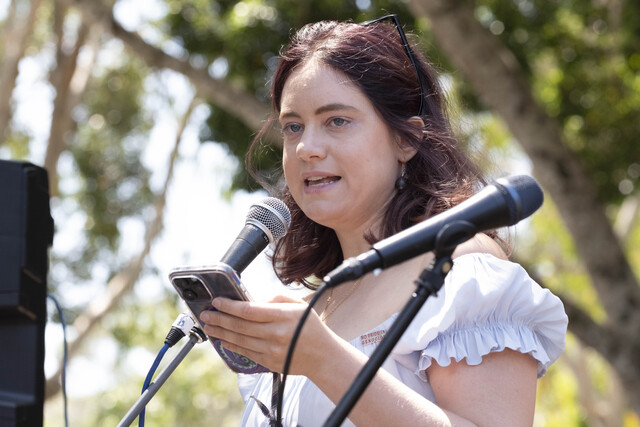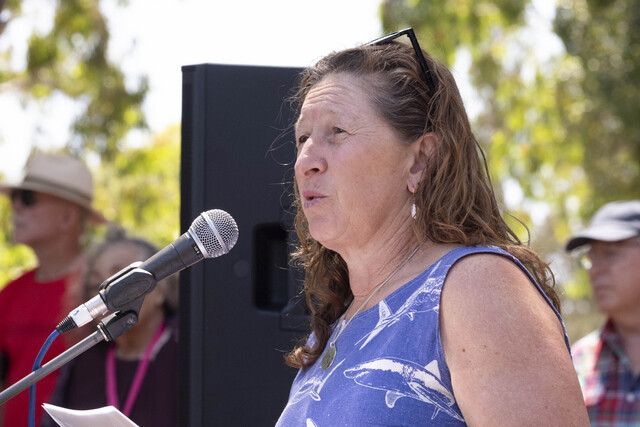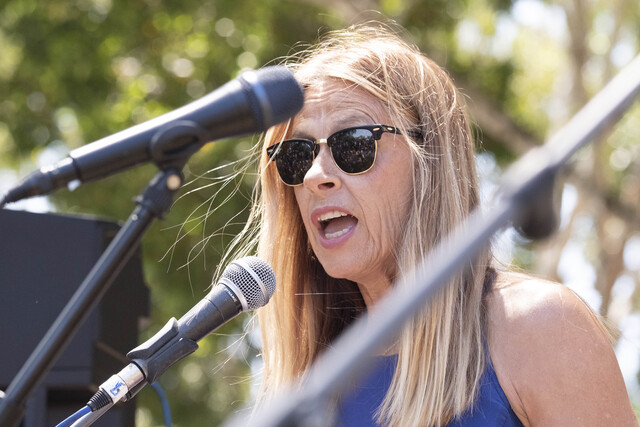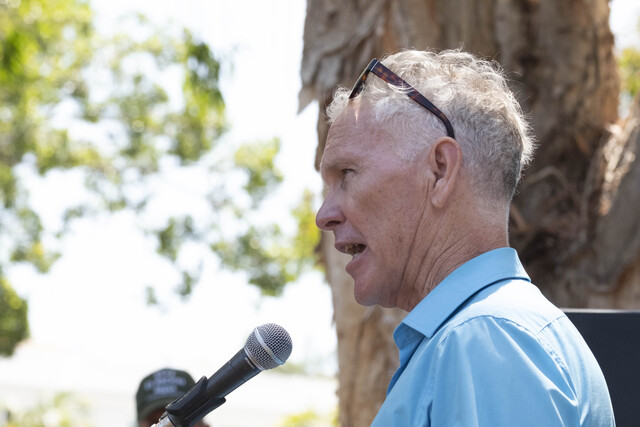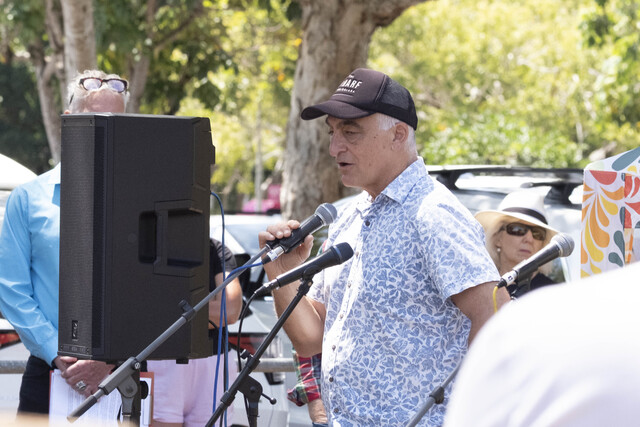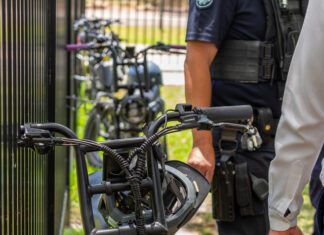“We’re here to voice our disapproval of the ongoing shark nets, particularly during the whale migration season,” former Mayor Tony Wellington told about 200 people who gathered in Noosa Heads Lions Park on Saturday before delivering their message in a peaceful protest march along Hastings Street and Main Beach.
The protest, led by local teacher Madeleine Boyd, brought together a group of key local speakers and began with a welcome to country from Kabi Kabi Elder Dr Hope O’Chin (Aunty Hope).
“The importance of being able to get on with nature, and look after nature is a responsibility that none of us can shrug off. It’s a part of who we are and preserving who we are not just for today but for our future,” Aunty Hope said.
The protest was organised because shark nets were not protection but destruction, Madeleine said. “They kill turtles, rays, dolphins, whales and other marine life, and yes, sharks too. More than 90 per cent of what’s caught in these nets is harmless. That’s not safety, that is cruelty,” she said.
“Real solutions that protect everyone – people and marine life is what we are looking for.”
In 2023 about 20 local groups who had independently been fighting for the removal of the shark nets were brought together at a roundtable meeting during which a working party named Oceans for All was formed.
Oceans for All chairperson Caz Lansdowne said since then the group had been “working with scientists, government departments, politicians and locals making sure we’ve got the most up to data, research on what’s going on out there in the field”.
“It’s time to remove those nets. The nets were first introduced in Australia in the 1930s. They weren’t brought in to protect people. They were brought in to simply reduce shark populations and we know now sharks are not resident in one area. They’re nomadic. They keep moving,” she said.
“In the 1960s we brought the shark nets to Noosa after we had a shark bite that, unfortunately, a surfer ended up dying, from blood poisoning post-bite. “Locals and visitors have this false sense of security that the nets are protecting them, believing the nets are saving lives.
“The truth is quite different. We’re still seeing serious incidents. In fact Noosa has had two more attacks, one in 1999 one in 2013 but people don’t seem to tell you about that.
“So here we are almost 100 years later using the same technology. It was never intended to be there to protect people but to kill sharks. The nets do kill – every year they catch and drown dolphins, turtles, rays and harmless sharks, ones that we don’t need to be killing, even endangered species.
“All of this within our UNESCO biosphere area. Every year we know that our migrating whales get entangled in this area causing dangerous and costly rescue missions.
“We want to protect swimmers, surfers and ocean users but not at the cost of ocean creatures that make Noosa waters so rich and alive.
“Together we can work to end this false sense of security, protect our marine life, keep our beaches safe. Together let’s work on if we can’t remove them, replace them, give us something that protects us without hurting everything else.”
Marine management expert and Tourism Noosa board director Kathleen Swalling who has worked in marine management for 30 years said the results of a Tourism Noosa survey of members showed 80 per cent supported the removal of shark nets during whale migration season.
“We do have an increase in population. We have a massive increase in the population of whales. We have increases in shark numbers,” she said.
“We do need management programs but we want to keep beaches safe. We want to allow whales, dolphins, sharks, other marine life to swim free. It’s an ocean, not a swimming pool.
“I’d like to see the shark control program transition from 1936-62, when the goal was to decrease shark population. We know this has resulted in a bycatch of non target species of 90 per cent, since 1962. We need to transition to alternatives, to smart drumlines with circular hooks that give us the opportunity to tag them and release them and we can track these sharks and then we can tell when they’re near populated areas and we can change our behaviours when they’re near populated areas.
“We can use the drones, there’s also (according to a new UN report) some new shark barriers that act like kelp. Sharks don’t like kelp.
“Today in Noosa we are leading into the Olympic Games. We have international obligations in relation to marine wildlife, we live in a biosphere.
“Australia is one of four countries that has shark nets, Queensland is the only state that leaves shark nets in during whale migration.
“We’ve seen from the Sunshine Coast to the Fraser Coast nine entanglements in 10 days, including two whales at Noosa, and a dolphin mother and baby. Kathleen urged attendees to use their voices to make a difference.
Former Mayor Tony Wellington said it was important to know shark nets were part of state government legislation. The Crisafulli government has contributed another $88million to shark control program, including more nets in Noosa, he said.
Mayor Frank Wilkie said the reason Noosa Council supported the removal of shark nets during whale migration season in favour of other mitigations such as catch alert drumlines and aerial surveillance drones, was due to their committment to caring for people and the fauna and flora of Noosa Shire.
“Noosa Council is taking an evidence-based approach to its position. In November the state government brought down the state government-commissioned KPMG report into the shark control program,” he said.
“One of its key recommendations was shark nets be removed during whale migration season and run in conjunction with other non-lethal mitigations such as catch-alert drumlines and surveillance drones and to use the data as a bench mark to inform permanent changes to the shark control program.
“The report indicates measures other than nets can target key predators and offer protection to humans while significantly reducing the deaths of other marine creatures such as rays, turtles, dolphins and dropping the rate of whale entanglements to zero per cent.
“The state government is increasing shark control measures. We’re hoping they may make an exception for us here.
“Noosa Council has written to the state government asking they trial the removal of shark nets during whale migration season while using other mitigation measures such as aerial drone surveillance and catch alert drum lines as per KPMG recommendation. As suggested in the KPMG report the majority of sharks in Queensland are caught in drumlines with only 10 per cent caught in nets.”
Cr Wilkie said another piece of Council advocacy was a motion put forward by Cr Amelia Lorentson.
“When we go to the LGAQ (Local Government Association of Queensland) conference we move this motion the LGAQ advocate to the state government to support any local government area in Queensland that wishes to trial the removal of shark nets,” he said.
Sunshine Coast councillor Joe Natoli said they did not have the majority numbers in his council to support asking the state government to remove shark nets as Noosa Council had done.
He said when you look at the statistics, the amount of money, hundreds of millions of dollars, poured into shark nets over the decades, doesn’t make sense.
“Shark attacks in terms of fatalities average about 2.8-3 a year, over the last 10 years. Since 1852 to 2013 there were 71 fatalities. Yet in Queensland in 2024 we had 7500 hospitalisations from car accidents, 302 people killed in one year,” he said.
“In Australia each year there are 3000 snake bites, the same number of fatalities as sharks.
“Why are we using technology that was preferred 80-odd years ago.
“None of us are advocating we are putting people at risk. Yet every minister in history says we put the value of people before marine creatures, but do little to reduce car fatalities or snake bites.
“In Western Australia a people movement brought about change, got rid of shark nets. In Queensland relying on the LNP or Labor won’t get change, unless the people bring that change about.”
Tony Wellington said the state government’s committment to maintaining and expanding shark control program was based on “populism not on science”.
“The science is clearly telling the government shark nets do not necessarily protect interaction between humans from shark attack and has a significant fall off in terms of bycatch,” he said.

